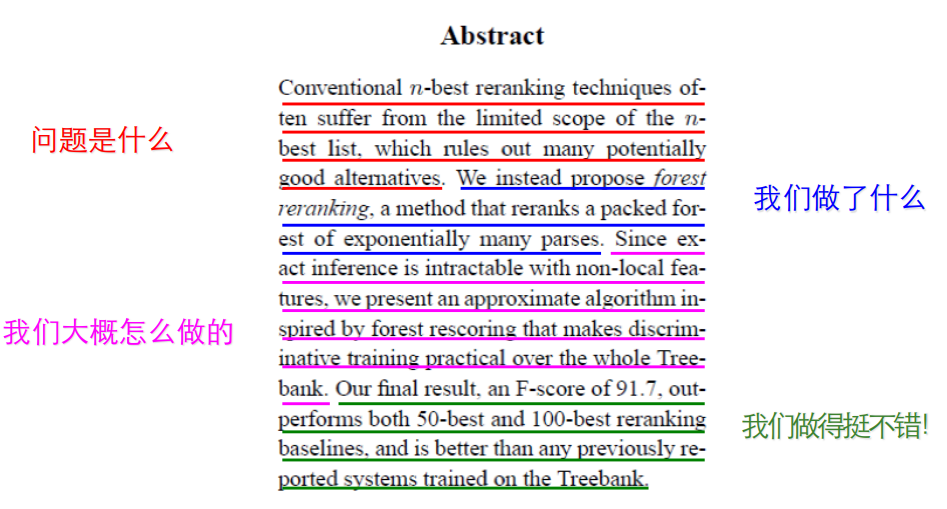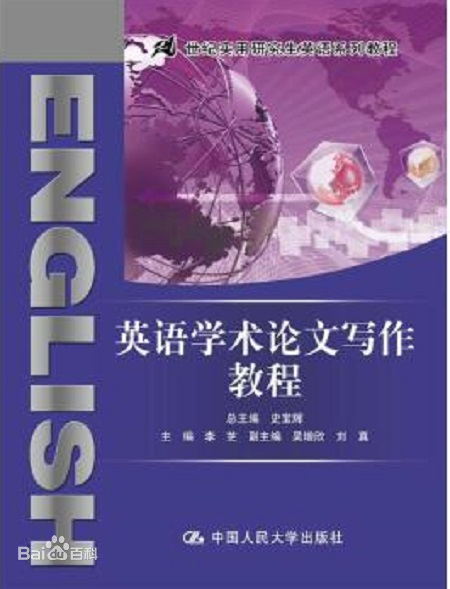学术论文写作教程笔记
第一次投论文 KSEM 2021,收到了 5 个 reviewer 给的意见,指出了我论文中的不足和改进的建议,这些意见非常宝贵,因此整理记录下来,日后写论文时要牢记。
存在的问题
- 在 Introduction 的结尾,应该用一个 road-map 段落列出整篇文章的结构。
- 一些英文表述模糊,应当提升英文写作技能。(这个后面我会专门学习T_T)
- 参考文献列表中的文献在文中出现时应当按照顺序:[1]、[2]、[3]…… 所有的参考文献都应在文中有提及。
能使文章更好的建议
- 相关工作中提到的模型最好和本文的模型形成对比实验。
- 用图展示实验部分的对比结果更为直观和清晰。
- 应对文中的算法给出详细的解释以便读者理解。
(写东西的时候写慢一点,争取一次到位;事情多的时候时间分块;打破自己的舒适区)
学术论文写作教程笔记
参考:MT学术论文写作方法和技巧 刘洋
摘要
问题是什么 -> 我们做了什么 -> 我们大概是怎么做的 -> 我们做得挺不错

Introduction
常见的逻辑:说明问题是什么 -> 简单罗列前人的工作 -> 描述我们的工作
更好的逻辑:说明问题是什么 -> 目前最好的工作面临什么挑战 -> 我们的方法能够缓解上述挑战
段落的写法
- 每个段落有个论断性的中心句
- 其余部分是支撑句,围绕中心句展开论证
- 前人工作
- 具体数据
- 支撑句之间可分类组织
- 段尾可以加上衔接句
Trick: 在首页放置一个图或者表,让读者一目了然你所做的工作
信息元素的易理解度:图 > 表格 > 正文 > 公式 > 算法 > 证明
图和表的重要性:图和表是论文的框架,争取让读者按照顺序看就能理解论文的主要思想,不用通过正文才能看懂
一般第一遍看,都会看图、找例子,然后翻到后面找主要结果,再从头看正文
把论文元素放在最应该被放在的地方,符合读者的认知惯性,降低理解难度(不要以自己为中心,而是以读者为中心)
方法的写作技巧
- 不要一上来就描述你的工作,可以先介绍背景知识(即 baseline)
- 例子是利器,全篇统一使用一个 running example 来阐释方法/baseline
- 逻辑顺序:首先给出 running example;然后利用 running example,用通俗语言描述想法;最后才是形式化的描述
实验的写作技巧
- 公认的标准数据和 state-of-the-art 系统
- 实验先辅后主
- 辅助实验(开发集):参数的影响
- 主实验(测试集):证明显著超过 baseline
- 必须有显著性检验
- 最好能直接看懂图,不用再去看正文
相关工作的写作技巧
错误:
- 没有引用重要论文(可以直接作为 rejection 的理由)
- 简单的罗列和堆砌,缺乏深刻到位的评论
- 通过批评乃至攻击前人工作证明你的工作的创新性
正确:
- 向审稿人显示你对本领域有全面深刻的把握
- 通过与前人工作的对比凸显你的工作的创新性
- 为读者梳理领域的发展脉络,获得全局的认识
写作常见问题
- 句子过长
- 经常使用被动句式
- 结构松散、口语化
- 定冠词和不定冠词的使用
- 公式后面文字的缩进:当公式后的文本与公式有关,则不缩进,否则缩进
- 引用的写法
其他技巧
- 论文中每个数学符号都应当找得到定义,除非众所周知。永远不要不加说明就使用数学符号
- 要避免数学符号冲突,使用符号列表
- 不要生造术语,尤其是中式译法,尽量符合惯例
- 集成所有信息元素,排版美观和专业
- 找著名学者(尤其是 native speaker)的论文钻研,学习句式和词汇用法,做笔记
工具
- Latex
- Bibtex:自动生成参考文献列表
- MetaPost:编程画矢量图
参考:英文SCI写作套话 pdf
没时间看了,有时间的话再看看吧。。。
参考:英语学术论文写作教程 史宝辉 中国人民大学出版社

Writing Foundation
- Know your readers
- Logic
- Style : Formal writing style rather than e-mail
Ten tips in creating academic style:- "We" is better than "I"
- Never use contractions
- Avoid using negative forms (否定形式)
- Avoid using vague expressions
- Do not address the reader directly (不要直接向读者讲话)
- Use indirect questions rather than direct ones
- Place the adverbs in the mid-position
- Do not split infinitives
- Try not to be too wordy
- Use both active and passive voices but be aware that passive voice renders a more academic sense
- Formality
- Phrases are often used under informal circumstances while words are used more formally.
- Information Flow
- Sentences follow a progression from old information to new information
- This + Summary Noun
- Can be widely used to refer to aforementioned information
- Nominalization (名词化)
- Nominalization gives priority to actions rather than to the people responsible for them
Introduction
Objective: (1) arouse readers' interest; (2) offer adequate information to prepare readers for understanding the paper and evaluating the worth if the study.
Basic skills: (1) relevant definition; (2) citations; (3) paraphrasing relevant work; (4) report the value of your study by using modal auxiliaries.
- Funnel-shaped Structure
- The top presenting the broadest view and the rest narrowing down to the specific research problem
- The CARS (Creating-a-Research-Space) Model
- Move 1: Establish a research territory
a. by showing that the general research area is important, central, interesting, problematic, or relevant in some way (optional)
b. by introducing and reviewing items of previous research in the area (obligatory) - Move 2: Establishing a niche (定位) by indicating a gap of the present research or by extending previous knowledge in some way (obligatory)
- Move 3: Occupying the niche
a. by outlining purposes of stating the nature of the present research (obligatory)
b. by listing research questions or hypotheses
c. by announcing principal findings
d. by stating the value of the present research
e. by indicating the structure of the RP
- Move 1: Establish a research territory
- Writing a Definition
- Short definition
- Sentence definition
- Extended definition
- Citations in Introduction
- Type One: Information Prominent Citation
(1) Writer + publication year
eg. Plasticity in plants is a very common response to environments (Schlichting, 1986).
(2) Reference number
eg. Fast charging level provides power to fully charge an EV battery in 20-30 minutes. [3] - Type Two: Writer Prominent Citation
(1) Writer's name + publication year
eg. Harper (2008) found that the relationships between some reproductive traits and plant size varied with different environmental conditions.
(2) Writer's name + reference number
eg. Gomez and Scher [4] indicate that logical thinking and correct spelling are integral in solving crossword puzzles.
- Type One: Information Prominent Citation
- Verb Tenses in Citations
Simple past (一般过去时), present perfect (现在完成时) and simple present (一般现在时) are commonly used in citations.
(1) Referring to single studies: simple past
(2) Referring to areas of inquiry: present perfect
(3) Referring to state of current knowledge: simple present - Paraphrasing
Common strategies: replacing words with synonyms; changing word order; changing sentence structure.
Original sentence:A number of studies have indicated that changes in the availability of light may result in variation in growth-related traits.
Important information:- Changes in the availability may influence some growth-related traits.
- Many studies has come to this conclusion.
Establish relationships: cause and effect
Linking words that can connect the points: due to, because, as a result, result in, result from
Possible synonyms: indicate -> demonstrate; a number of -> many
A paraphrased version: The finding that the change of growth-related traits would result from differences in light availability was demonstrated in many studies.
- Establishing a Niche
Corresponds to Move 2, usually short (1 or 2 sentences). Four methods to establish a niche:- Counter-claiming (something is wrong)
- Indicating a gap in previous research (Something is missing)
- Raising a question about previous research (something is unclear)
- Continuing a tradition (adding something)
A shift from Move 1 to Move 2 would suggest a transition from general background to critical literature review. - Connectors: however, but, despite, although, yet, nevertheless...
- Verbs: lack, fail, ignore, neglect, limit, misinterpret, hinder, question...
- Adjective: little, few, unreliable, unsatisfactory, inefficient, scarce, limited, uncertain, unclear, controversial, unconvincing, questionable...
- Occupying the Niche
- Purposes or Nature of the Research
Obligatory, outlining purposes or stating the method of the present research. - Verb Tenses
The subject is about the type of text/paper/article: simple present
The subject is about the type of investigation/experiment/study: simple past - Research Question
May be inferred from the purposes of nature of the research - Research Value
When reporting value of your study, you should not make it sound too definite. By using modal auxiliaries(may, can, would), the statements sound more cautious and acceptable. - Outline of the paper
- Purposes or Nature of the Research
- Information Flow: old-to-new Pattern
Four ways to indicate old information:- Repeat the words
- Use the synonyms of the words
- Use pronouns or demonstrative pronouns
- This/These + summary noun
Materials and Methods
Results
Discussion and Conclusion
Abstract
Title
由于时间关系,剩下几块没看,这本书主要提供了普适通用的学术写作方法,不专门针对 CS 领域。
留个坑,以后有时间的话再看吧(大概率是不会再回来了。。。)
此外,还有一些 中国作者英文科学写作中的常见语法问题:http://muchong.com/html/201508/9312437.html
和 英文写作经典指导书:https://blog.csdn.net/luolan9611/article/details/81141377





【推荐】国内首个AI IDE,深度理解中文开发场景,立即下载体验Trae
【推荐】编程新体验,更懂你的AI,立即体验豆包MarsCode编程助手
【推荐】抖音旗下AI助手豆包,你的智能百科全书,全免费不限次数
【推荐】轻量又高性能的 SSH 工具 IShell:AI 加持,快人一步
· 开发者必知的日志记录最佳实践
· SQL Server 2025 AI相关能力初探
· Linux系列:如何用 C#调用 C方法造成内存泄露
· AI与.NET技术实操系列(二):开始使用ML.NET
· 记一次.NET内存居高不下排查解决与启示
· Manus重磅发布:全球首款通用AI代理技术深度解析与实战指南
· 被坑几百块钱后,我竟然真的恢复了删除的微信聊天记录!
· 没有Manus邀请码?试试免邀请码的MGX或者开源的OpenManus吧
· 园子的第一款AI主题卫衣上架——"HELLO! HOW CAN I ASSIST YOU TODAY
· 【自荐】一款简洁、开源的在线白板工具 Drawnix